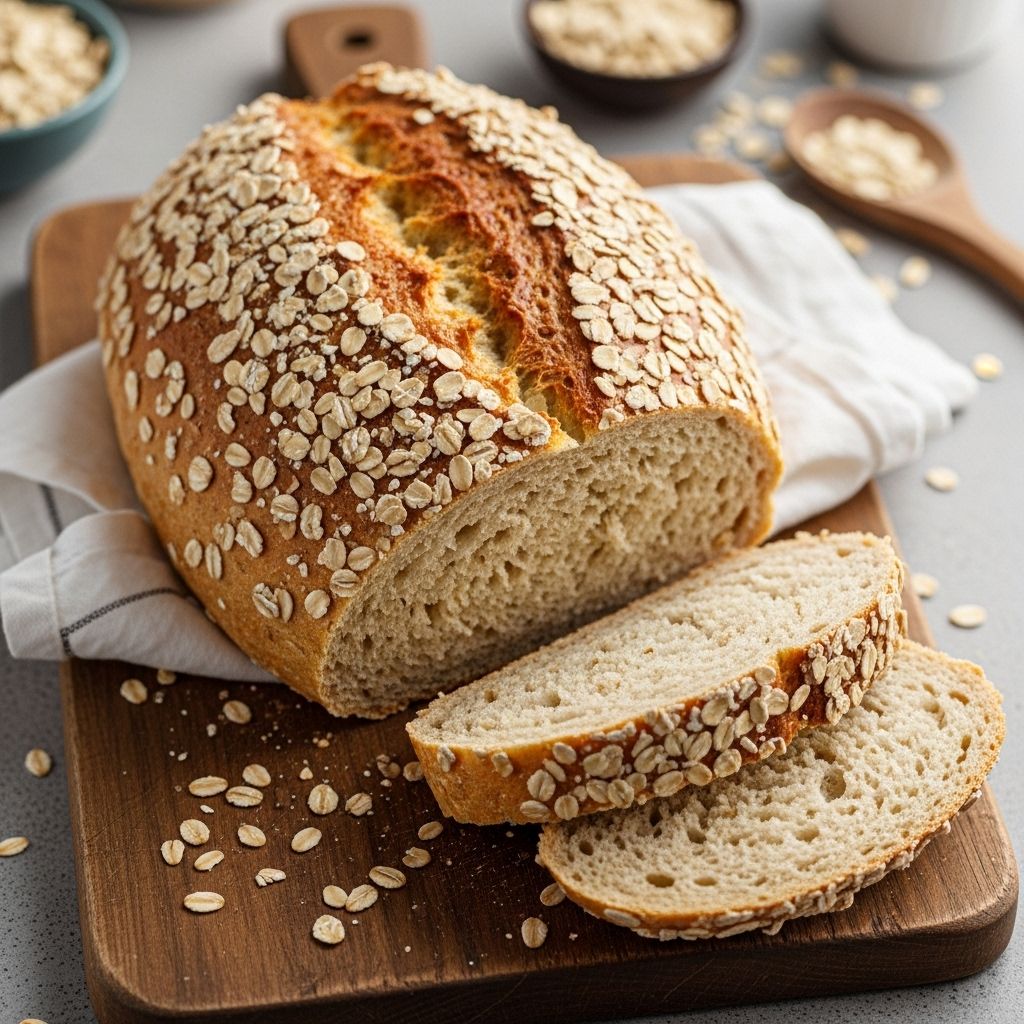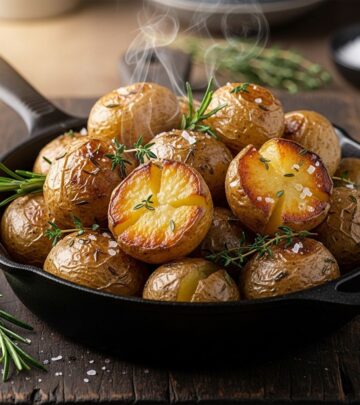Oats 101 and How to Make Perfect Oatmeal Sandwich Bread
A simple method turns humble oats into tender, flavorful slices you’ll love any time.

Oats 101 and Oatmeal Sandwich Bread
If you are searching for the perfect homemade bread for sandwiches, toast, or even French toast, look no further than oatmeal sandwich bread. Infused with the wholesome flavor of oats and boasting a tender crumb, this bread will elevate your kitchen and your meals. Before diving into the recipe, let’s explore the world of oats—what they are, how they’re processed, and the unique qualities each type brings to your cooking and baking.
Table of Contents
- Understanding Oats: Types and Uses
- Which Oats Are Best for Baking?
- Oatmeal Sandwich Bread Recipe
- Step-by-Step Bread Baking Guide
- Tips, Tricks, and Variations
- Frequently Asked Questions
Understanding Oats: Types and Uses
Oats are a staple grain that have nourished people for centuries—relied upon for breakfast, baking, and everything in between. Knowing the difference between types of oats will help you choose the right one for your recipes and maximize flavor and texture.
1. Old-Fashioned (Rolled) Oats
Old-fashioned oats, also known as rolled oats, are the classic variety found in most home pantries. During processing, whole oat groats are steamed and then rolled flat. This creates uniform, thin flakes that cook quickly, approximately 5 minutes on the stove top, and offer a pleasant, tender texture.
- Best for: Baking (cookies, bars, breads), breakfast oatmeal, granola.
- Texture: Flat, slightly chewy, cooks quickly.
- Flavor: Mild and nutty.
2. Quick-Cooking Oats
Quick oats are simply rolled oats that have been cut into smaller pieces before rolling. This allows them to cook much faster—often in as little as 1 minute. The texture is softer and less distinct than old-fashioned oats since their pieces are smaller and thinner.
- Best for: Baking where a less prominent oat texture is desired, quick hot cereals.
- Texture: Softer, finer, quicker to cook.
3. Instant Oats
Instant oats are the most processed variety. These are pre-cooked, dried, and rolled even thinner than quick oats, then chopped into tiny pieces. These oats are most commonly found in flavored packets containing sugar, fruit pieces, and other ingredients. Their minimal texture means they cook very rapidly—often just by adding boiling water.
- Best for: Instant oatmeal packets, very quick breakfasts.
- Texture: Very soft and mushy after cooking.
4. Steel Cut Oats
Steel cut oats are the least processed. Whole oat groats are simply chopped into small pieces with steel blades, leaving them rugged, hearty, and chewy. These oats take the longest to cook—about 30 minutes or more—and offer more bite and nuttiness than rolled versions.
- Best for: Hearty breakfast porridge, savory grain bowls.
- Texture: Chewy, chunky, dense; retains shape after cooking.
| Oat Type | Processing | Cooking Time | Texture |
|---|---|---|---|
| Old-Fashioned (Rolled) | Steamed & rolled flat | 5 min | Chewy, thin flakes |
| Quick Oats | Cut & rolled thinner | 1 min | Soft, finer |
| Instant Oats | Pretreated & finely chopped | Instant | Mushy, fine |
| Steel Cut Oats | Chopped whole oats | 30 min | Hearty, nutty, chewy |
Which Oats Are Best for Baking?
When it comes to baking—especially for recipes like oatmeal bread or cookies—old-fashioned rolled oats are the gold standard. Their balance of texture, cook time, and flavor makes them an ideal choice for both structure and taste. Quick oats can be used in a pinch, resulting in a slightly softer crumb and less visible oat flecks. Instant oats are not recommended for bread, as they tend to dissolve completely, robbing the bread of character and chew.
Oatmeal Sandwich Bread Recipe
This oatmeal sandwich bread is everything you want in a loaf: soft, fluffy, hearty, and subtly sweet. It’s wonderful fresh, makes sensational toast, and is sturdy enough for any sandwich filling. Making two loaves means you have plenty to share, or just freeze one for later!
Ingredients
- 2 cups old-fashioned oats
- 2 cups boiling water
- 1/2 cup light brown sugar, packed
- 1/4 cup unsalted butter, diced
- 4 1/2 cups bread flour
- 2 teaspoons salt
- 1 1/2 tablespoons instant yeast
- 1/2 cup nonfat dry milk powder
- Additional butter for greasing pans and brushing tops
Equipment
- Large mixing bowl
- Wooden spoon or stand mixer with dough hook
- Plastic wrap or damp towel
- Two 8.5 x 4.5-inch loaf pans
Step-by-Step Bread Baking Guide
1. Prepare Oat Mixture
Start by placing oats, brown sugar, and diced butter into a large mixing bowl. Pour boiling water over the mixture. Stir, then let it rest for 10-15 minutes, until warm but not hot. This allows the oats to soften and flavors to meld.
2. Combine Dry Ingredients
In a separate bowl, whisk together flour, salt, instant yeast, and dry milk powder. This ensures even distribution of the rising agents and keeps your bread uniform in texture.
3. Mix Wet and Dry
Add the cooled oat mixture to the dry ingredients. Stir to form a shaggy dough. If you have a stand mixer, use the dough hook to mix until combined. The dough should be soft, slightly sticky, but should pull away from the sides of the bowl.
4. Knead and First Rise
Knead dough for about 8 minutes by hand (or 5 minutes in a stand mixer), until smooth and elastic. Place in a greased bowl, cover with plastic wrap or a damp towel, and let rise in a warm place for around 60–90 minutes, or until doubled in size.
5. Shape and Second Rise
Punch down the dough gently to release air. Divide evenly into two portions. Shape each into a log and fit into buttered loaf pans. Cover loosely and let rise again for 45–60 minutes, until loaves have domed above the rim of the pan.
6. Bake
Preheat the oven to 350°F (175°C). Brush the tops of the loaves with melted butter and, if you wish, sprinkle extra oats on top for a rustic finish. Bake for 35–40 minutes until golden brown and the loaves sound hollow when tapped.
7. Cool and Serve
Let loaves cool in the pans for 5 minutes, then turn out onto a wire rack to cool completely. Brush with more butter if desired. Slice and enjoy!
Tips, Tricks, and Variations
- Freezer-friendly: This bread freezes perfectly. Slice, wrap tightly, and freeze for up to three months.
- Whole wheat option: Substitute up to half the bread flour for whole wheat flour. The bread will be slightly denser and extra wholesome.
- Add-ins: Fold in 2/3 cup raisins, dried cranberries, or chopped nuts before shaping for a fun twist.
- Texture tweak: Prefer a slightly denser loaf? Use all quick oats instead of old-fashioned oats.
- Honey swap: Replace the brown sugar with honey or maple syrup for a subtler sweetness and aroma.
Frequently Asked Questions (FAQs)
Q: Can I use quick or instant oats for this bread recipe?
A: Quick oats can be substituted for old-fashioned oats with only a minor texture change—the bread will be a bit softer. For best results, avoid instant oats, as these dissolve too much and will alter bread structure.
Q: What is the best way to store homemade oatmeal bread?
A: Cool completely, store in an airtight bag or container at room temperature for up to 3 days. For longer storage, slice and freeze the bread.
Q: How do I make my bread sandwich-perfect?
A: Be patient during rises for a fluffy, even crumb, and don’t slice until completely cool for neat, sturdy slices. Freezing slices in advance helps keep loaves fresh and handy for sandwiches, too.
Q: Is oatmeal bread healthier than white bread?
A: Oatmeal bread provides additional fiber, nutrients, and healthy fats from the oats, making it a more nutritious option than standard white sandwich bread.
Q: Can I make this recipe dairy-free?
A: Yes! Substitute non-dairy butter and a plant-based milk powder or simply omit the dry milk for a dairy-free version. The bread will still be delicious.
Conclusion
Once you try this oatmeal sandwich bread recipe, you may never go back to store-bought loaves. The simple, nourishing combination of oats, flour, and a touch of sweetness yields bread that is delicious for any meal—whether as toast in the morning, sandwich at noon, or alongside a warming soup at supper. Enjoy your journey into the wonderful world of oats and let this bread become a staple in your home kitchen.
References
Read full bio of medha deb












